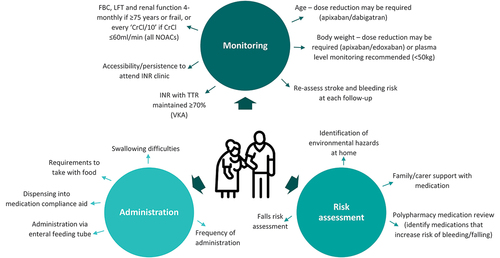Figures & data
Table 1. Secondary analyses of phase III trials comparing non-vitamin K antagonist oral anticoagulants vs. warfarin in people aged ≥75 years.
Table 2. Non-vitamin K antagonist oral anticoagulant prescribing aid for older people and high-risk subgroups, based on product licensing and available randomized and observational data.
Table 3. Key findings from meta-analyses investigating the effect of oral anticoagulant use (vs. nonuse) and choice of oral anticoagulant (NOAC vs. VKA) on dementia or cognitive impairment in AF.
Figure 1. Practical considerations when prescribing oral anticoagulant therapy for stroke prevention in AF in older people.

Table 4. Summary characteristics and outcomes of individual studies included in a systematic review and meta-analysis by Guo et al [Citation112] comparing non-vitamin K antagonist oral anticoagulant vs. vitamin K antagonist therapy in people with AF and prior history of stroke, transient ischemic attack and intracranial hemorrhage.
